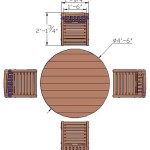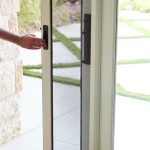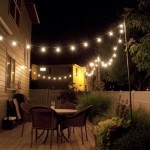Curtains for Patio: Enhancing Outdoor Living Spaces
Patio curtains serve as more than just decorative additions to an outdoor living area. They are functional elements that contribute to privacy, weather protection, and overall comfort. Selecting the appropriate curtains for a patio involves considering various factors, including material, style, and specific needs of the space. This article explores the key aspects of patio curtains, providing insights into making informed decisions for creating an enjoyable and functional outdoor environment.
Understanding the Benefits of Patio Curtains
Patio curtains offer a multitude of advantages, transforming an open patio into a versatile and comfortable extension of the home. These benefits extend beyond aesthetics, contributing to the practicality and usability of the outdoor space throughout the year.
One of the primary benefits is enhanced privacy. In densely populated areas or when a patio faces a public space, curtains provide a visual barrier, shielding occupants from unwanted attention. This allows for a more relaxed and intimate outdoor experience, making the patio a true extension of the private living space.
Another significant advantage is weather protection. Patio curtains can act as a buffer against harsh sunlight, reducing glare and preventing the fading of outdoor furniture. They can also offer protection from mild rain and wind, allowing for continued use of the patio even during less-than-ideal weather conditions. The level of protection varies depending on the material chosen, with heavier, more durable fabrics offering greater resistance to the elements.
Furthermore, patio curtains contribute to temperature regulation. By blocking direct sunlight, they can help to keep the patio cooler during hot summer months. Conversely, in cooler weather, heavier curtains can help to trap heat, creating a more comfortable environment. This temperature regulation can also translate to energy savings by reducing the need for air conditioning inside the home.
Finally, patio curtains can serve as an effective insect deterrent. While not a complete solution, they can significantly reduce the presence of mosquitoes and other flying insects, making the patio a more enjoyable space to relax and entertain. Pairing curtains with other insect control measures can further enhance their effectiveness.
Choosing the Right Materials for Patio Curtains
The selection of material is a critical decision when choosing patio curtains. The material dictates the curtain's durability, weather resistance, and overall aesthetic. Several options are available, each with its own set of advantages and disadvantages.
Outdoor-specific fabrics, such as solution-dyed acrylic, are a popular choice due to their exceptional resistance to fading, mildew, and water damage. Solution-dyed acrylic is manufactured with the color integrated into the fibers, ensuring long-lasting color vibrancy even under prolonged exposure to sunlight. These fabrics are also easy to clean and maintain, making them ideal for outdoor use.
Polyester is another commonly used material for patio curtains. It is cost-effective, durable, and relatively resistant to wrinkles and shrinking. However, standard polyester may not be as resistant to fading as solution-dyed acrylic. Therefore, it is important to choose outdoor-rated polyester fabrics that have been treated with UV protectants to prolong their lifespan.
Canvas, a heavy-duty cotton fabric, offers a more natural look and feel. However, canvas is susceptible to mildew and water damage if not properly treated. To make canvas suitable for outdoor use, it must be treated with water-repellent and mildew-resistant coatings. Regular maintenance is required to prevent deterioration and extend its lifespan.
Sheer fabrics, such as voile or lightweight polyester, can be used for creating a soft and airy ambiance. These fabrics provide minimal privacy and weather protection but can be effective in diffusing sunlight and creating a romantic atmosphere. Sheer curtains are best suited for patios that are already partially sheltered or in climates with mild weather conditions.
Consider the climate and the desired level of protection when selecting the material for patio curtains. For areas with harsh sunlight, frequent rain, or strong winds, durable and weather-resistant fabrics are essential. For more moderate climates, a wider range of materials can be considered, allowing for greater flexibility in design and style.
Styles and Installation of Patio Curtains
Beyond material selection, the style and installation method of patio curtains play a significant role in their functionality and aesthetic appeal. Various styles are available, each offering a different look and level of privacy.
Tab top curtains are a classic and versatile option, featuring fabric loops at the top that slide onto a curtain rod. This style is easy to install and creates a relaxed, casual look. However, tab top curtains may not glide as smoothly as other styles, especially with heavier fabrics.
Grommet top curtains have metal rings inserted along the top edge, allowing them to slide easily onto a curtain rod. This style creates a modern and streamlined look. Grommet top curtains are particularly well-suited for heavier fabrics, as the grommets provide added support and durability.
Rod pocket curtains have a sewn-in pocket at the top that the curtain rod slides through. This style offers a clean and tailored appearance. Rod pocket curtains can be more challenging to install and may not glide as easily as grommet top curtains. They are best suited for curtains that are not frequently opened and closed.
Tie-top curtains feature fabric ties that are used to attach the curtain to the rod. This style adds a touch of whimsy and charm. Tie-top curtains are relatively easy to install but may require more adjustments to ensure even spacing and draping.
The installation method depends on the chosen style and the existing structure of the patio. Curtain rods are the most common method of installation, requiring brackets that are mounted to the wall, ceiling, or posts. Choose a curtain rod that is strong enough to support the weight of the curtains, especially if using heavy fabrics. Cables or wires can also be used to hang curtains, creating a more minimalist and modern look. These are often used with grommet or tab top curtains.
Consider adding tiebacks or curtain rods to hold the curtains open when not in use. This allows for maximizing natural light and airflow. Motorized patio curtains offer the ultimate convenience, allowing for remote control operation. These are typically more expensive to install but provide a hassle-free way to adjust the curtains as needed.
Maintaining Patio Curtains for Longevity
Proper maintenance is crucial for prolonging the lifespan and maintaining the appearance of patio curtains. Regular cleaning and care can prevent the buildup of dirt, mildew, and other contaminants that can damage the fabric.
Regularly brush or vacuum the curtains to remove loose dirt and debris. This simple step can prevent the buildup of grime and keep the fabric looking fresh. For more thorough cleaning, follow the manufacturer's instructions. Many outdoor fabrics can be machine-washed on a gentle cycle with mild detergent. Avoid using harsh chemicals or bleach, as these can damage the fabric and fade the colors.
For spot cleaning stains, use a mild soap and water solution. Gently blot the stain with a clean cloth, avoiding harsh rubbing that can damage the fabric. Rinse the area with clean water and allow it to air dry completely. For stubborn stains, consider using a specialized fabric cleaner designed for outdoor use.
To prevent mildew growth, ensure that the curtains are completely dry before storing them. If the curtains are frequently exposed to moisture, consider treating them with a mildew-resistant spray. Regularly inspect the curtains for signs of mildew and address any issues promptly.
During the off-season or periods of prolonged inactivity, store the patio curtains in a clean, dry place. Wrap the curtains in breathable fabric or store them in a storage bag to protect them from dust and pests. Avoid storing the curtains in damp or humid environments, as this can promote mildew growth.
Periodically inspect the curtain rods or other hardware for signs of wear and tear. Tighten any loose screws or bolts and replace any damaged components. Ensure that the hardware is properly maintained to prevent accidents and ensure the curtains function properly.
By following these maintenance tips, patio curtains can maintain their beauty and functionality for years to come, providing a stylish and comfortable outdoor living space.

Pro Space 50 In X 84 Outdoor Curtains For Patio Waterproof Porch Privacy D On Top And Bottom Curtain Navy 1 Panel Ouc5084sxdbg The Home Depot

Topchances Outdoor Curtain For Patio Waterproof Extra Long Rustproof Grommet Public Divider Blackout Thermal Insulated Drape Pergola Porch 1 Panel Com

Topchances 2 Panels Grey Outdoor Curtains For Patio Waterproof Extra Wide 52 X 84 Inch Blackout Thermal Insulated Gray Porch Pergola Pool Arbor Com

Outdoor Porch Curtains Weather Protection

Pro Space 50 W X 96 L Water Wind Resistant Outdoor Curtain For Patio Porch Gazebo Cabana Greyish White Otcg5096gw The Home Depot

Diy Patio Curtains From Drop Cloths With No Sewing Tered Thoughts Of A Crafty Mom By Jamie Sanders

Waterproof Indoor Outdoor Curtains For Patio Privacy Sun Blocking Grommet Curtain Panel Weatherproof Uv Resistant Gazebo Front Porch Pergola 1pc Shein

Grommet Windproof Waterproof Outdoor Curtains Canvas For Patio Gazebo Pergola And Porch 1 Panel Kgorge

Easy Going Outdoor Curtains For Patio Waterproof Cabana Grommet Curtain Panels Beige 52 X 84 Inch Set Of 2 Com

10 Best Outdoor Curtains 2024
Related Posts








